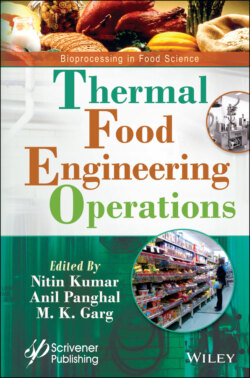Читать книгу Thermal Food Engineering Operations - NITIN KUMAR - Страница 28
1.3.4 Ohmic Heating 1.3.4.1 Principal and Mechanism
ОглавлениеHeating technology has observed some recent advances with the following technology development, viz Dielectric heating (Radiofrequency and microwaves), induction and Ohmic heating. Ohmic Heating or joule heating is electro-heating, or electroconductive heating or direct electric resistance heating in which heat generated within the food material is due to the generation of alternating electric current passed through the food material. In 1900, the Ohmic heating technique was utilized for the Pasteurization of infant milk. In the early twentieth century, the electro-pure process was relevant commercially, but later with time, it became prevalent during the 1980s.
The food itself acts conductor in electric resistance heating as the voltages are applied, the current between the electrode and ground helps in determining the resistivity of the food as per Ohm’s law. Increasing the current or voltage, thereby increase in temperature increases the conductivity of foods [54].
In Ohmic heating, unlike other thermal methods, the electrode is in contact with food; less frequency is applied compared to the frequency of radio or microwaves, and the waveform is usually a sine wave. Resistance heating systems help with the production of products with high storage stability through proper maintenance of food in terms of color and nutritional value [34]. Figure 1.2 depicts the circuit diagram of static (batch type) resistance heating process [46].
Ohmic heating is defined as the amount of heat generated in which electrical current passes through the food and current resisting the flow of electricity. Its principle is based on the direct application of Ohm’s Law, wherein, the current through the conductor between the two points is directly proportional to the voltage.
Figure 1.2 Circuit diagram of static (batch type) resistance heating process [46].
Heat is generated internally due to the alternating current applied to the food, and the OH ratio is directly dependent on the electrical conductivity of food.
Voltage by the alternating current applied at both ends of the electrode, which interacts directly with the supplied food. Food treated in the ohmic heating chamber should come in contact with the electrodes. Since food contains the right amount of ionic salts and water molecules, electrical energy is converted into thermal energy to generate heat internally, and almost all energy inputs convert to heat without a loss factor. The heat generated can be used for other food processes such as Pasteurization, sterilization, and blanching related to OH applications. Resistance heating devices instrumentation includes an electrode (electrodes may be of stainless steel, aluminum, titanium, or platinum-coated titanium), power supply, an insulating tube or container or a heating chamber trapping the food sample inside it, data logger system, a current sensor, a thermocouple, and a Personal computer. The significant parameters involved are electrode configuration (flow of current across or parallel to the product flow direction), the gap between the two electrodes, heater shape, AC frequency, the voltage applied, the speed of the product, a supply of electricity, amount of charge per unit time. Some other factors considered are the type of product and its properties in particular specific conductance and rate of heating; total solids in food material, the heat capacity, viscousness of the material, density, the size and shape of the particles, and inclination of an electric field. The electric field intensity, E and σ, the electrical conductance, and Q are the heating rate that is directly proportional to the field strength and the square of the electrical conductivity. The increased temperature, conductance determine the efficiency of OH and the values of temperature, voltage, current, the time displayed in the data acquisition system [61].
The electric field in the homogeneous medium determined by:
E0 = ∇U, in which U is the electrostatic potential
So, generation of heat per unit volume would be;
where σL defined as the electrical conductivity of dispersed or liquid materials
Changes in the conductance with the temperature for solid and liquid foods mostly taken in a linear form, described as follows:
wherein, σin described as the electrical conductivity at the start point of temperature Tin and m is described as a constant of proportionality (°C-1)
The resistance in the ohmic heating defined as:
where R is total heat resistance in ohms, Rs (ohms per meter) is specific product resistance, x(m) is the gap between the electrodes, and A(m2) is the electrode area.
